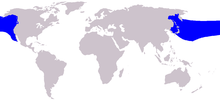Baird's beaked whale
| Giant beaked whale | |
|---|---|
 |
|
| Size of Arnoux's beaked whale compared to an average human | |
 |
|
| Size of Baird's beaked whale compared to an average human | |
| Scientific classification | |
| Kingdom: | Animalia |
| Phylum: | Chordata |
| Class: | Mammalia |
| Order: | Artiodactyla |
| Infraorder: | Cetacea |
| Family: | Ziphiidae |
| Subfamily: | Berardiinae |
| Genus: |
Berardius Duvernoy, 1851 |
| Binomial name | |
|
Berardius arnuxii Duvernoy, 1851 |
|
 |
|
| Arnoux's beaked whale range | |
|
Berardius bairdii Stejneger, 1883 |
|
 |
|
| Baird's beaked whale range | |
Giant beaked whales are three species of beaked whales in the genus Berardius: Arnoux's beaked whale (Berardius arnuxii) in cold Southern Hemisphere waters, and Baird's beaked whale (Berardius bairdii) in the cold temperate waters of the North Pacific. An as yet unnamed third species was described in 2016. They are the largest of the beaked whales, growing up to 10–12 m in length. Lifespan estimates, based on earwax plug samples,indicate these whales can live up to 85 years. They are sometimes referred to as "four-toothed whales" or "giant beaked whales", but are most commonly known by their genus name, Berardius. Arnoux's and Baird's beaked whales are so similar that researchers have debated whether or not they are simply two populations of the same species. However, genetic evidence and their wide geographical separation has led them to be classified as separate.
The two established species have very similar features and would be indistinguishable at sea if they did not exist in disjoint locations. Arnoux's is generally smaller. Estimated lengths of live Arnoux's at sea have been up to 12 m (39 ft), but all dead specimens have been considerably smaller of around 9.3 m (31 ft) to 9.75 m (32.0 ft). The Baird's, on the other hand, have been confirmed to grow to 12–13 m (39–43 ft). The weight is up to 14,000 kg (31,000 lb).
Both whales have a very long prominent beak, even by beaked whale standards. The lower jaw is longer than the upper and the front teeth are visible even when the mouth is fully closed. The melon is particularly bulbous. The body shape is slender—the girth is only 50% of length. The body is uniformly coloured and a particular individual's colour may be anything from light grey through to black. The flippers are small, rounded and set towards the front of the body. The dorsal fin similarly is small and rounded and set about three-quarters of the way along the back. Adult males and females of both species pick up numerous white linear scars all over the body as they age and may be a rough indicator of age. There is little sexual dimorphism in either species.
A third and as yet unnamed species (informally known as "Karasu" (Japanese for raven)) was described in 2016, based on differences in mtDNA haplotypes between black and gray forms of Baird's beaked whale in the North Pacific. For the time being, the following text treats Baird's beaked whale as monospecific.
The total population is not known for two of the three species. Estimates for Baird's are of the order of 30,000 individuals. Nothing is known at all about the population size or distribution for the newly discovered third species of Berardius.
...
Wikipedia
